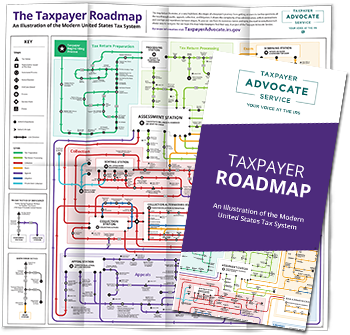Collection Station — Collection Actions
-
Levy/Seizure of Assets
View our interactive tax map to see where you are in the tax process. It could help you navigate your way through the IRS.
View our interactive tax map to see where you are in the tax process. It could help you navigate your way through the IRS.

The IRS assessed the tax and sent you a bill reflecting a balance on your tax account. However, you neglected or refused to pay the tax. A notice of intent to levy was sent to you previously letting you know how much you owe, when it was due, how to pay and that you have the right to appeal this action. Since the IRS did not hear from you it is continuing with its collection process.
The IRS can levy or seize a taxpayers wages and other income, bank accounts, business assets, personal assets (including your car and home), retirement accounts (including the Thrift Savings Plan), Alaska Permanent Fund Dividends, state tax refunds, and Social Security benefits up to the amount the taxpayer owes.
If you have a tax debt, the IRS can issue a levy, which is a legal seizure of your property or assets. It is different from a lien — while a lien makes a claim to your assets as security for a tax debt, the levy takes your property (such as funds from a bank account, Social Security benefits, wages, your car, or your home).
The IRS is using a levy to satisfy a tax debt since you have not paid the balance owing or made other payment arrangements with the IRS.
where the IRS takes an asset all at once. For example, a levy on your bank account takes only what is in the account at the time your bank receives the levy. The IRS must issue another levy to reach funds placed in your account later.
They remain in place until the IRS releases the levy or your debt is paid in full. For example: If you have a levy on your wages or certain federal payments, the levy will have a continuous effect.
The IRS can also use the Federal Payment Levy Program (FPLP) to levy continuously on certain federal payments you receive, such as Social Security benefits. A TAS brochure, What You Need to Know: the Federal Payment Levy Program, can help you understand FPLP.
Other examples of assets the IRS might levy are your state tax refunds and payments you’re to receive from clients (accounts receivable). For specifics, see Levies on the TAS website.
The IRS is using a levy to satisfy a tax debt since you have not paid the balance owing or made other payment arrangements with the IRS.
The first thing to do is to check the return address to be sure it’s from the Internal Revenue Service and not another agency.
If it’s from the IRS, the notice of levy will have instructions on how to respond to the levy and who to contact. If the notice is not from the IRS, visit I Got a Notice From the IRS for further details.
If you disagree with the IRS that you owe the debt, you need to respond to the notice of levy and tell the IRS why you think you don’t owe the debt. You may be able to raise your arguments in a Collection Due Process (CDP) Equivalent Hearing or request an audit reconsideration. Please note that if you disagree with the IRS Independent Office of Appeals (Appeals) decision in the Eequivalent Hhearing, you have no right to judicial review by the United States Tax Court. See Publication 1660, Collection Appeal Rights and Publication 5, Your Appeal Rights and How to Prepare a Protest If You Don’t Agree, for more information.
You need to figure out what payment options might work for your situation, and act to set up a payment plan or other way to pay off your balance and request a levy release. Being proactive in addressing the tax debt may prevent additional penalty and interest charges and eliminate the need for the IRS to take further action to collect the balance. For specifics, see Levies on the TAS website and Revocation or Denial of Passport in Case of Certain Unpaid Taxes for further information.
If the levy is creating an economic hardship on you, meaning you’re unable to meet basic, reasonable living expenses, then contact the IRS at the number on the levy or notice immediately.
Appeals is separate from and independent of the IRS Collection office that initiated the collection action. You can also ask that the IRS manager review your case informally. You can obtain the manager’s name and phone number by contacting the employee listed on your notice. IRS employees are required to give you their manager’s name and phone number. For specifics, see Levies on the TAS website and Levy Relief on the TAS Roadmap. See Publication 594, The IRS Collection Process, and Publication 1660 for a full explanation of how to appeal a collection action.
Note: For each tax and period, the IRS is generally required to notify you before the first time it collects or intends to levy and will send you a Notice of Your Right to a Collection Due Process Hearing (CDP).
If the tax being levied stems from the filing of a joint return and you believe your current or former spouse should be solely responsible for an incorrect item or an underpayment of tax on the return, you may be eligible for relief as an Innocent Spouse.
If you believe you have an acceptable reason for interest or a penalty to be removed or reduced, you may complete Form 843, Claim for Refund and Request for Abatement or send a signed statement to the IRS explaining your reasons. For specific instructions, see Notice 746, Information About Your Notice, Penalty and Interest.

Understanding your notice or letter
For more specifics on your notice, visit Understanding your IRS Notice or Letter on IRS.gov
Get Help topics
Browse common tax issues and situations at TAS Get Help
What You Need to Know: Federal Payment Levy Program
Levies on the TAS website
Levies on IRS.gov
If you still need help
The Taxpayer Advocate Service is an independent organization within the IRS that helps taxpayers and protects taxpayers’ rights. We can offer you help if your tax problem is causing a financial difficulty, you’ve tried and been unable to resolve your issue with the IRS, or you believe an IRS system, process, or procedure just isn’t working as it should. If you qualify for our assistance, which is always free, we will do everything possible to help you.
Visit dev.taxpayeradvocate.irs.gov or call ![]() 1-877-777-4778.
1-877-777-4778.
Low Income Taxpayer Clinics (LITCs) are independent from the IRS and TAS. LITCs represent individuals whose income is below a certain level and who need to resolve tax problems with the IRS. LITCs can represent taxpayers in audits, appeals, and tax collection disputes before the IRS and in court. In addition, LITCs can provide information about taxpayer rights and responsibilities in different languages for individuals who speak English as a second language. Services are offered for free or a small fee. For more information or to find an LITC near you, see the LITC page on the TAS website or Publication 4134, Low Income Taxpayer Clinic List.
Related Letters or Notices
Collection Station — Collection Actions